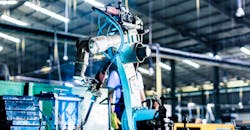If it wasn’t already clear to manufacturers that the use of robots is on the rise, the numbers leave little doubt: Millions are installed annually, according to the International Federation of Robotics.
Industrial robots have long been used to replace human workers in performing tasks that are dangerous, dirty, or repetitive. These robots are often large, bulky, caged machines doing the heavy lifting in packaging and palletizing.
Collaborative robots (aka cobots) are designed to work safely alongside humans in shared workspaces. These robots, with their increased flexibility and dexterity, can complete more delicate tasks conventional robots cannot, such as polishing fragile materials in production processes.
Cobots are smaller, lighter, and safer than conventional industrial robots. Demand for this technology is on the rise, with the global cobot market expected to reach $9 billion by 2025.
Because of their flexibility and relative ease-of-use compared to fully automatic robots, cobots are generally considered to be an affordable and attractive choice for small and medium sized businesses. These businesses can benefit from robot’s traditional value proposition—they do repetitive or unsafe tasks, freeing up human workers to do more complex work, and without taking compensation.
Before investing in cobots, it’s important manufacturers make a thorough risk assessment. Risk assessments could uncover the need for extra safety features, low operating speeds, or even multiple stops. These extras add significantly to the cost of using cobots. In fact, according to TM Robotics’ Global Robotics Report 2018, 79% of automation distributors don’t think that their customers fully understand the safety requirements that come with using a cobot and therefore are unlikely to budget for the necessary additional features.
ISO 10218 sets the safety requirements for industrialized robots. However, for cobots, which will have more interactions with humans, these guidelines aren’t enough.
That’s why ISO/TS 15066 guidelines were introduced in 2016. They supplement ISO 10218 and ensure machines classed as collaborative meet specific safety requirements. Requirements also pertain to tools that get installed on the robot’s arm to perform tasks, as well as objects handled by it. For the first time, ISO/TS 15066 outlines a cobot’s maximum allowed power and speed limits. It also clarifies what is necessary when assessing risks of cobot applications. For example, the assessment must consider the entire collaborative workspace and how operators will interact with the cobot. Manufacturers must also assess the risks of foreseeable contact between operators and the cobot for any job it is expected to do.
Engineers need to carefully examine every task the cobot will complete in detail—an oversimplified assessment will not accurately represent how safe the robot will be. Here, manufacturers should consider the safety concept of ALARA (as low as reasonably achievable). Manufacturers must consider all potential risks, not just one or two of them.
For business reasons, manufacturers must consider production speeds and volumes they want when deciding between cobots and traditional industrial robots. To run efficiently, assembly lines of humans and cobots must run at the human workers’ speed to avoid bottlenecks on the production line.
Manufacturers in sectors such as bottling and packaging that need higher speeds or volumes can benefit from buying conventional robots. The logic is simple: Fewer human operators means fewer chances to slow production, and several industrial robots can be combined into a fully automated production line. Industrial robots are automatically controlled and can be programmed in three or more axes. They can carry out an extremely broad range of processes unattended. Crucially, programming these machines is easy, so operators don’t need to have advanced programming skills to use them. Many of these robots can use AI and machine-learning software to master processes—and even improve on them, self-coding programs when necessary.
Upgrading a factory so that cobots work alongside existing legacy equipment and human workers is an attractive proposition for many businesses, but it is one that requires selective investments and careful obsolescence management.
Widespread growth in cobots illustrates they are a common first step toward automated manufacturing. Cobots also require little safeguarding equipment so installation costs are low. However, for large, complex manufacturing setups, full-size industrial robots may still offer better economies of scale.
Jonathan Wilkins is director at EU Automation.


